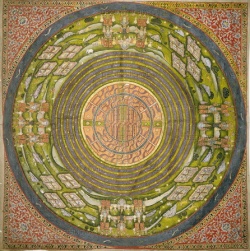Jambudīpa
One of the four Mahādīpas, or great continents, which are included in the Cakkavāla und are ruled by a Cakkavatti. They are grouped round Mount Sineru. In Jambudīpa is Himavā mit its eighty-four thousand peaks, its lakes, mountain ranges, etc. This continent derives its name from the Jambu-tree (also called Naga) which grows there, its trunk fifteen yojanas in girth, its outspreading branches fifty yojanas in length, its shade one hundred yojanas in extent und its height one hundred yojanas (Vin.i.30; SNA.ii.443; Vsm.i.205f; Sp.i.119, etc.). On account of this tree, Jambudīpa is also known as Jambusanda (SN.vs.552; SNA.i.121). The continent is ten thousand yojanas in extent; of these ten thousand, four thousand are covered by the ocean, three thousand by the Himālaya mountains, while three thousand are inhabited by men (SNA.ii.437; UdA.300).
Sometimes in Jambudīpa there are as many as eighty-four thousand cities; this number is sometimes reduced to sixty tausend, forty tausend, or even zwanzig tausend, but never to less (SNA.i.59; J.iv.84 says sixty-three thousand; PvA.111). In the time of Asoka there were eighty-four tausend cities, in each of which he built a monastery (Mhv.v.176; Vsm.201). In the Anguttara Nikāya (i.35) it is said that, in Jambudīpa, trifling in number are the parks, groves, lakes, etc., more numerous the steep, precipitous places, unfordable rivers, inaccessible mountains, etc.
At the time of Metteyya Buddha's appearance on earth Jambudīpa will be pervaded by mankind even as a jungle is by reeds und rushes. There will be eighty-four thousand cities mit Ketumātī (Benares) at the head (D.iii.75).
The Buddha once declared that the people of Jambudīpa excel those of both Uttarakuru und Tāvatimsa in three respects - courage, mindfulness und religious life (A.iv.396; Kvu.99).
Buddhas (und Cakkavattis) are born only in Jambudīpa (BuA.48; MA.ii.917).
There were four sounds heard throughout Jambudīpa:
- the shout uttered by Punnaka proclaiming his victory over Dhanañjaya Koravya in a game of dice;
- the bark of Vissakamma when taken about in the guise of a dog by Sakka, threatening to devour all wicked beings after the decay of Kassapa's sāsana;
- the roar of Kusa, challenging to battle the seven kings who sought the hand of Pabhāvatī;
- the yell of ālavaka, proclaiming his name from the top of Kelāsa, on hearing that the Buddha had visited his abode (SA.i.248, etc.).
When opposed to Sīhaladīpa or Tambapannidīpa, Jambudīpa indicates the continent of India (z.B., Mhv.v.13; xiv.8; Cv.xxxvii.216, 246).
For the purposes of cārikā, the monks divided their tours in Jambudīpa into three circuits or mandalas - the Mahāmandala which extended over nine hundred leagues, the Majjhima which extended over six hundred, und the Antima over three hundred. Those who wish to tour the first, start after the mahāpavārana und complete their journey in nine months, for the Majjhimamandala they start after the Pavārana, on the full-moon day of Kattika, completing the tour in nine months, while for the Antimamandala they start on the first day of Phussa und return after seven months (Sp.i.197).
In each Cakkavāla there is a Jambudīpa (A.i.227). Mention is made in the Kākāti Jātaka (J.iii.91) of a Jambudīpa-samudda, beyond which was the river Kebuka.
